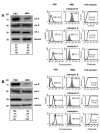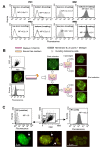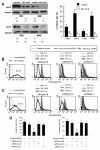Cathepsin B inhibition interferes with metastatic potential of human melanoma: an in vitro and in vivo study
- PMID: 20684763
- PMCID: PMC2925371
- DOI: 10.1186/1476-4598-9-207
Cathepsin B inhibition interferes with metastatic potential of human melanoma: an in vitro and in vivo study
Abstract
Background: Cathepsins represent a group of proteases involved in determining the metastatic potential of cancer cells. Among these are cysteinyl- (e.g. cathepsin B and cathepsin L) and aspartyl-proteases (e.g. cathepsin D), normally present inside the lysosomes as inactive proenzymes. Once released in the extracellular space, cathepsins contribute to metastatic potential by facilitating cell migration and invasiveness.
Results: In the present work we first evaluated, by in vitro procedures, the role of cathepsins B, L and D, in the remodeling, spreading and invasiveness of eight different cell lines: four primary and four metastatic melanoma cell lines. Among these, we considered two cell lines derived from a primary cutaneous melanoma and from a supraclavicular lymph node metastasis of the same patient. To this purpose, the effects of specific chemical inhibitors of these proteases, i.e. CA-074 and CA-074Me for cathepsin B, Cathepsin inhibitor II for cathepsin L, and Pepstatin A for cathepsin D, were evaluated. In addition, we also analyzed the effects of the biological inhibitors of these cathepsins, i.e. specific antibodies, on cell invasiveness. We found that i) cathepsin B, but not cathepsins L and D, was highly expressed at the surface of metastatic but not of primary melanoma cell lines and that ii) CA-074, or specific antibodies to cathepsin B, hindered metastatic cell spreading and dissemination, whereas neither chemical nor biological inhibitors of cathepsins D and L had significant effects. Accordingly, in vivo studies, i.e. in murine xenografts, demonstrated that CA-074 significantly reduced human melanoma growth and the number of artificial lung metastases.
Conclusions: These results suggest a reappraisal of the use of cathepsin B inhibitors (either chemical or biological) as innovative strategy in the management of metastatic melanoma disease.
Figures






Similar articles
-
Effect of cysteine proteinase inhibitors on murine B16 melanoma cell invasion in vitro.Biol Chem. 2002 May;383(5):839-42. doi: 10.1515/BC.2002.088. Biol Chem. 2002. PMID: 12108549
-
An intracellular form of cathepsin B contributes to invasiveness in cancer.Cancer Res. 2001 Apr 15;61(8):3493-500. Cancer Res. 2001. PMID: 11309313
-
Effects of E-64 (cysteine-proteinase inhibitor) and pepstatin (aspartyl-proteinase inhibitor) on metastasis formation in mice with mammary and ovarian tumors.In Vivo. 1994 Mar-Apr;8(2):231-6. In Vivo. 1994. PMID: 7919127
-
Development of cathepsin inhibitors and structure-based design of cathepsin B-specific inhibitor.Curr Top Med Chem. 2010;10(7):696-707. doi: 10.2174/156802610791113441. Curr Top Med Chem. 2010. PMID: 20337581 Review.
-
Cathepsin B: A sellsword of cancer progression.Cancer Lett. 2019 May 1;449:207-214. doi: 10.1016/j.canlet.2019.02.035. Epub 2019 Feb 20. Cancer Lett. 2019. PMID: 30796968 Free PMC article. Review.
Cited by
-
Cell death-based treatments of melanoma:conventional treatments and new therapeutic strategies.Cell Death Dis. 2018 Jan 25;9(2):112. doi: 10.1038/s41419-017-0059-7. Cell Death Dis. 2018. PMID: 29371600 Free PMC article. Review.
-
The function of cathepsins B, D, and X in atherosclerosis.Am J Cardiovasc Dis. 2016 Nov 30;6(4):163-170. eCollection 2016. Am J Cardiovasc Dis. 2016. PMID: 28078176 Free PMC article.
-
Emerging Roles for Ion Channels in Ovarian Cancer: Pathomechanisms and Pharmacological Treatment.Cancers (Basel). 2021 Feb 7;13(4):668. doi: 10.3390/cancers13040668. Cancers (Basel). 2021. PMID: 33562306 Free PMC article. Review.
-
Nitroxoline impairs tumor progression in vitro and in vivo by regulating cathepsin B activity.Oncotarget. 2015 Aug 7;6(22):19027-42. doi: 10.18632/oncotarget.3699. Oncotarget. 2015. PMID: 25848918 Free PMC article.
-
Association between cathepsins and skin cancers: A bidirectional two-sample Mendelian randomization study.Skin Res Technol. 2024 Aug;30(8):e13905. doi: 10.1111/srt.13905. Skin Res Technol. 2024. PMID: 39138831 Free PMC article.
References
Publication types
MeSH terms
Substances
LinkOut - more resources
Full Text Sources
Other Literature Sources
Medical

